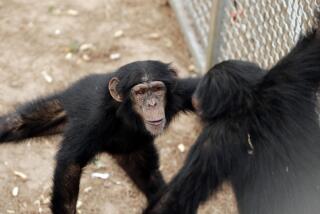Magpies, humans share a rare trait
- Share via
Babies love mirrors. But not until they approach the age of 2 do toddlers make the connection between the baby in the mirror and themselves. Recognizing ourselves in a mirror is one of the traits that make humans, well, human.
Now it appears that self-recognition also makes magpies magpies. Best known for stealing shiny objects, the black-and-white magpie is the first bird to join a short list of mammals shown to share this trait: humans, chimpanzees, dolphins and elephants.
German psychologists Helmut Prior of Goethe University in Frankfurt and Ariane Schwarz and Onur Gunturkun of Ruhr University-Bochum put European magpies through the classic “mark” test, the same test used on humans and other mammals.
Researchers marked the throats of five magpies -- where they couldn’t see -- with either brightly colored or black adhesive dots.
In a series of tests, each bird -- Gerti, Goldie, Harvey, Lilly and Schatzi -- was then placed in either a cage with a mirror or a cage with a nonreflective plate.
Harvey and Lilly ignored the mirrors; like some of us, they apparently didn’t care how they looked.
But Gerti, Goldie and Schatzi, when confronted by their refections, attempted to peck and scratch at their brightly colored dots.
The birds largely ignored the black dot, which blended into their black feathers, showing that they weren’t merely responding to how the dots felt or smelled.
Although the number of birds tested was small, the proportion that responded to the mark in the presence of a mirror matched chimpanzees, the authors wrote.
Their findings, published Tuesday in the online journal PLoS Biology, were notable as an example of convergent evolution, the development of similar traits in organisms with very different ancestries.
The evolutionary lines leading to birds and mammals separated about 300 million years ago. The capacity for self-recognition is so rare in mammals -- hundreds have failed the mark test -- that it is unlikely to have been passed down from that long-ago common ancestor.
“Our study is the first showing the capability of self-recognition must have emerged independently at least two times,” Prior said.
And it emerged in very different brains. Birds don’t have a neocortex, the folded outer layer of the brain that, in mammals, researchers believe is responsible for intelligence and consciousness.
Magpies have already made strides in turning the phrase “bird brain” into a compliment. They belong to the corvid family, which includes jays, crows and ravens, some of which are known to fashion tools out of sticks and to play tricks.
Prior said he would not be surprised if other members of that avian family could also pass the mark test.
--




